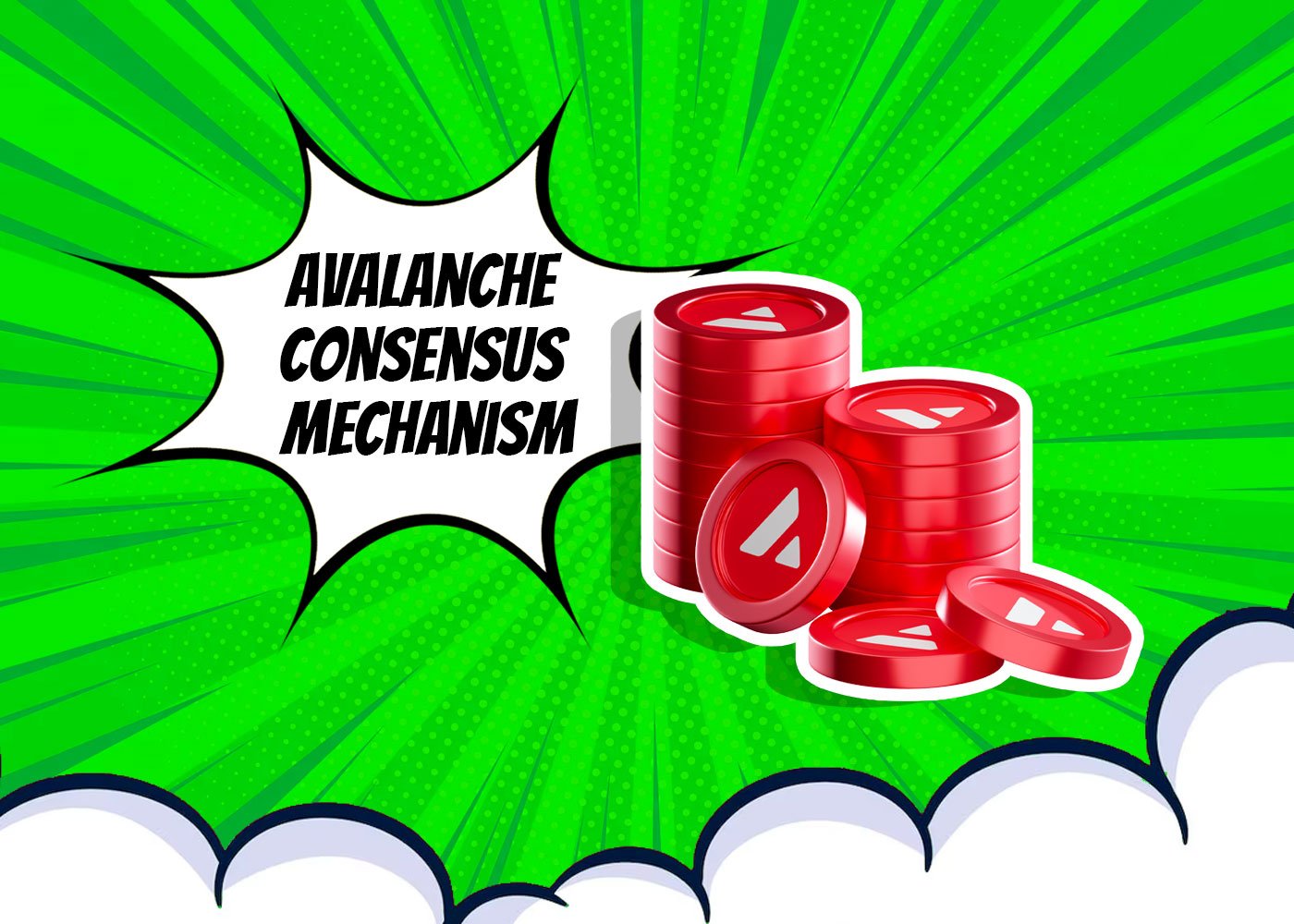Avalanche Blockchain consensus mechanisms are a critical component of the distributed ledger technology that powers cryptocurrencies such as Bitcoin and Ethereum. A consensus mechanism is a set of rules that enables a network of computers to agree on the state of the blockchain without the need for a central authority or intermediary. There are several consensus mechanisms used in blockchain networks, each with its unique advantages and drawbacks.
One of the most well-known consensus mechanisms is Proof of Work (PoW), which requires miners to solve complex mathematical problems to validate transactions and create new blocks. This process is resource-intensive, as it requires a significant amount of computational power to solve these problems. Another popular consensus mechanism is Proof of Stake (PoS), which works by requiring network participants to stake a certain amount of cryptocurrency as collateral.
This incentivizes participants to act in the best interest of the network, as they stand to lose their stake if they behave maliciously. Other consensus mechanisms, such as Delegated Proof of Stake (DPoS) and Practical Byzantine Fault Tolerance (PBFT), have also emerged to address specific challenges associated with PoW and PoS. Overall, consensus mechanisms are a crucial aspect of blockchain networks that enable them to operate in a decentralized and trustless manner.
In conclusion, blockchain consensus mechanisms are a vital component of the decentralized ledger technology that underpins cryptocurrencies. They enable networks of computers to agree on the state of the blockchain without the need for a central authority or intermediary, thereby creating a trustless and transparent system. Different consensus mechanisms offer different advantages and drawbacks, and it is essential for blockchain developers to choose the mechanism that best suits their network’s specific needs. By understanding the intricacies of these mechanisms, we can better appreciate the immense potential of blockchain technology to transform industries and change the way we interact with each other.
Importance of Consensus for Secure and Decentralized Systems
The importance of consensus for secure and decentralized systems cannot be overstated. Without consensus, decentralized systems such as blockchain networks would be vulnerable to attacks and manipulation, rendering them ineffective as a secure and trustworthy means of exchanging information and value. Consensus mechanisms are essential to ensuring that all participants in a decentralized network agree on the state of the system, which in turn guarantees that transactions are validated and recorded in a transparent and immutable manner. This is crucial for maintaining the integrity of the network and ensuring that no single participant can abuse their power or manipulate the system for their own gain.
Furthermore, consensus is a fundamental aspect of decentralization, which is one of the primary benefits of blockchain technology. Decentralization ensures that no single entity controls the network, making it resistant to censorship, corruption, and other forms of malicious activity. Consensus mechanisms enable decentralized networks to achieve this by allowing participants to come to a consensus on the state of the network without the need for a central authority or intermediary. This creates a trustless and transparent system that operates based on a set of predefined rules, making it more resistant to attacks and manipulation. Overall, consensus is essential for building secure and decentralized systems that can operate in a transparent and trustworthy manner, and it is critical to the success of blockchain technology and other decentralized systems.
What is the Avalanche Consensus Mechanism?
Avalanche is a relatively new consensus mechanism that aims to address some of the scalability and security issues associated with other consensus mechanisms such as Proof of Work (PoW) and Proof of Stake (PoS). It is a leaderless, decentralized consensus mechanism that uses a unique approach to achieve consensus in a highly efficient and secure manner.
Avalanche works by creating a dynamic, subnetwork of validators who independently validate transactions and reach consensus on the state of the network. This is achieved through a process called “metastability,” where the network achieves a state of equilibrium through a series of rapid feedback loops between nodes. This allows the network to achieve consensus quickly and efficiently, even in the face of high transaction volumes or network disruptions. Additionally, Avalanche is highly secure, as it uses a probabilistic finality mechanism that makes it extremely difficult for attackers to reverse transactions or manipulate the network. Overall, Avalanche is an innovative consensus mechanism that has the potential to significantly improve the scalability and security of blockchain networks, and it will be interesting to see how it evolves in the coming years.
Configuring Avalanche Consensus Algorithm
Avalanche consensus algorithm is a relatively new consensus mechanism that seeks to address some of the scalability and security issues associated with existing consensus mechanisms. The algorithm is designed to operate in a decentralized and leaderless manner, with nodes working together to achieve consensus on the state of the network.
The Avalanche consensus algorithm operates by creating a dynamic subnetwork of validators who independently validate transactions and reach consensus on the state of the network. This is achieved through a process called “metastability,” where the network achieves a state of equilibrium through a series of rapid feedback loops between nodes. Unlike other consensus mechanisms, Avalanche does not rely on pre-determined block sizes or block times, which can limit scalability and create bottlenecks in the network. Instead, it allows nodes to make independent decisions about which transactions to validate, resulting in a more flexible and efficient consensus process.
Additionally, Avalanche uses a probabilistic finality mechanism that makes it extremely difficult for attackers to reverse transactions or manipulate the network, making it highly secure. Overall, the Avalanche consensus algorithm is an innovative and promising approach to achieving consensus in a decentralized and secure manner, and it will be interesting to see how it evolves and is adopted by the blockchain community.
Role of Validators and Stakers in Consensus
Validators and stakers play a crucial role in achieving consensus in blockchain networks that use proof-of-stake (PoS) or delegated proof-of-stake (DPoS) consensus mechanisms. Validators are responsible for validating transactions and creating new blocks, while stakers hold a certain amount of cryptocurrency as collateral and participate in the consensus process by voting on the validity of transactions and blocks.
Validators and stakers are incentivized to act in the best interest of the network, as they stand to earn rewards for their participation. In PoS and DPoS networks, validators and stakers are often required to hold a minimum amount of cryptocurrency as collateral, which incentivizes them to act honestly and helps to prevent malicious actors from taking control of the network. Additionally, validators and stakers are typically required to meet certain performance metrics, such as maintaining high uptime and avoiding double-signing, to continue participating in the network. This helps to ensure that the network remains secure and reliable over time. Overall, validators and stakers play a critical role in achieving consensus in PoS and DPoS blockchain networks, and their participation is essential to maintaining the integrity and security of the network.
In conclusion, validators and stakers are an essential component of consensus mechanisms in blockchain networks. They are responsible for validating transactions, creating new blocks, and ensuring the security and reliability of the network. Validators and stakers are incentivized to act honestly and in the best interest of the network, which helps to prevent malicious actors from taking control and manipulating the system. As blockchain technology continues to evolve, the role of validators and stakers is likely to become even more important, and it will be interesting to see how these roles evolve in the future.
Steps involved in Avalanche consensus process
The Avalanche consensus process involves several steps that are designed to achieve consensus on the state of the network in a highly efficient and secure manner. The first step in the process is transaction submission, where users submit transactions to the network for validation. Once a transaction is submitted, it is broadcast to the network and received by the participating nodes.
The second step in the Avalanche consensus process is the voting phase, where validators and stakers vote on the validity of the transaction. This is done through a process of rapid feedback loops between nodes, where nodes communicate with each other to determine the consensus opinion on the validity of the transaction. If a transaction receives enough votes, it is considered validated and added to the blockchain. The process is then repeated for subsequent transactions, with the network continually seeking consensus on the state of the network. Overall, the Avalanche consensus process is designed to be highly efficient and secure, and it offers a promising approach to achieving consensus in a decentralized and scalable manner.
Advantages of Avalanche Consensus
High Throughput and Scalability
High throughput and scalability are important considerations for blockchain networks, as they determine the network’s ability to process transactions quickly and efficiently. High throughput is achieved by optimizing the network’s consensus mechanism and underlying infrastructure, while scalability is achieved by ensuring that the network can handle an increasing number of transactions as it grows. By achieving high throughput and scalability, blockchain networks can support a larger user base and a wider range of applications, making them more versatile and useful. Many blockchain projects are actively working on improving their throughput and scalability, with new consensus mechanisms and infrastructure solutions being developed to address these challenges. Overall, achieving high throughput and scalability is a critical step in the continued development and adoption of blockchain technology.
Low Transaction Fees
Low transaction fees are an important consideration for blockchain networks, as they determine the cost of using the network and can impact its adoption and usability. High transaction fees can discourage users from using the network and can make it difficult for small transactions to take place. Many blockchain projects are actively working on reducing transaction fees, by optimizing their underlying infrastructure and adopting new fee models that are more user-friendly. Some projects are also exploring new ways to subsidize transaction fees, such as by tokenomics or other innovative incentive structures. Overall, achieving low transaction fees is a critical step in making blockchain technology more accessible and usable for a wider range of users and applications.
Resistance to Sybil Attacks
Resistance to Sybil attacks is an important consideration for blockchain networks, as Sybil attacks can compromise the integrity and security of the network. Sybil attacks involve a malicious actor creating multiple fake identities to gain control of the network and manipulate its transactions. To resist Sybil attacks, many blockchain projects use identity verification mechanisms, such as proof-of-work or proof-of-stake, that require participants to prove their computational or financial resources. Other projects use reputation-based systems that rely on social consensus to validate the identity of network participants. By resisting Sybil attacks, blockchain networks can maintain their security and integrity, and ensure that they remain a trusted and reliable platform for transactions and applications.
Robustness Against Network Partitioning
Robustness against network partitioning is an important consideration for blockchain networks, as it determines the network’s ability to function even in the event of network disruptions or failures. Network partitioning can occur when a portion of the network becomes isolated from the rest of the network, due to factors such as network congestion or physical damage to infrastructure. To ensure robustness against network partitioning, many blockchain projects use consensus mechanisms that are designed to handle partitions and ensure that the network remains operational even in the face of disruptions. Other projects use redundancy and backup mechanisms to ensure that critical network components are always available, regardless of network conditions. By ensuring robustness against network partitioning, blockchain networks can provide a reliable and secure platform for transactions and applications, even in challenging environments.
Security Risks in a Permissionless Network
Permissionless networks, also known as public networks, are vulnerable to several security risks due to their open and decentralized nature. One of the main security risks in permissionless networks is the possibility of 51% attacks, where a malicious actor gains control of most of the network’s computing power and can manipulate transactions or create new blocks. Other security risks include double-spending attacks, where a user spends the same cryptocurrency twice, and Sybil attacks, where a malicious actor creates multiple fake identities to manipulate the network.
In order to mitigate these security risks, many permissionless networks use consensus mechanisms that are designed to make it difficult for a single entity to gain control of the network, as well as other security measures such as encryption and multi-factor authentication. Overall, while permissionless networks offer a high degree of openness and accessibility, they also require careful attention to security to ensure their integrity and reliability.
Lack of Incentives for Validators
Lack of incentives for validators is an important consideration for blockchain networks, as validators play a critical role in maintaining the integrity and security of the network. Validators are responsible for validating transactions and creating new blocks in the blockchain, and are typically rewarded with cryptocurrency for their efforts. However, if the rewards are not sufficient to incentivize validators, they may not be willing to participate in the network, which can compromise its security and reliability. To address this issue, many blockchain projects offer a variety of incentives for validators, including transaction fees, block rewards, and other benefits such as access to exclusive network features. Additionally, some projects use innovative incentive models, such as proof-of-stake, that reward validators based on their financial stake in the network. By providing adequate incentives for validators, blockchain networks can ensure that they have a robust and reliable group of participants who are committed to maintaining the network’s security and integrity.
Centralization Concerns
Centralization concerns are an important consideration for blockchain networks, as centralization can compromise the openness and transparency of the network. Centralization occurs when a single entity or a small group of entities gain control over a significant portion of the network’s resources or decision-making power, which can limit the network’s ability to operate in a decentralized manner. Centralization concerns can arise in a number of ways, including through the use of centralized exchanges, mining pools, or governance models.
To address these concerns, many blockchain projects are focused on decentralizing their networks through the use of distributed consensus mechanisms, such as proof-of-stake or proof-of-work, and by promoting wider participation and decision-making power among network participants. By mitigating centralization concerns, blockchain networks can maintain their open and transparent nature, and provide a reliable and trustworthy platform for transactions and applications.
Use Cases for Avalanche Consensus
Blockchain technology has a wide range of potential applications in industries such as finance, supply chain, and many others. In finance, blockchain technology can be used to streamline payment processing, reduce transaction costs, and improve transparency and accountability. It can also be used for securities trading, digital identity verification, and other financial applications. In the supply chain industry, blockchain technology can be used to track the movement of goods, reduce fraud and counterfeiting, and improve efficiency and accountability.
Other potential applications include voting systems, social media platforms, and decentralized cloud storage solutions. As the technology continues to evolve and new use cases are identified, it is likely that blockchain will become an increasingly important part of many industries, and will continue to transform the way that businesses and organizations operate.
Adoption
Adoption by blockchain projects such as Ava Labs and others is a testament to the growing importance and potential of blockchain technology. Ava Labs, for example, has developed the Avalanche consensus mechanism, which is designed to provide a high degree of scalability, security, and decentralization. Other blockchain projects, such as Ethereum, Polkadot, and Cardano, are also focused on advancing the capabilities of blockchain technology and promoting wider adoption across industries.
As more and more organizations recognize the potential of blockchain technology, and as the technology continues to mature and evolve, it is likely that we will see increasing adoption across a wide range of industries and use cases. With its ability to provide secure, transparent, and decentralized solutions, blockchain technology has the potential to transform the way that businesses and organizations operate, and to create new opportunities for innovation and growth.
Conclusion
The Avalanche consensus mechanism is an innovative approach to consensus that is designed to provide a high degree of scalability, security, and decentralization. Unlike other consensus mechanisms, which rely on a fixed number of validators to confirm transactions and create new blocks, Avalanche allows for dynamic participation, meaning that any network participant can become a validator at any time. This enables the network to achieve consensus more quickly and efficiently, and to remain secure even in the face of malicious actors.
Additionally, Avalanche offers high throughput and low transaction fees, making it an attractive option for a wide range of applications. Overall, the Avalanche consensus mechanism offers a number of important advantages over traditional consensus mechanisms, and is a promising development in the evolution of blockchain technology.
Potential Challenges and Criticisms of the Algorithm
While the Avalanche consensus mechanism has many advantages, there are also potential challenges and criticisms that should be considered. One potential challenge is the possibility of a “nothing at stake” attack, in which validators may have an incentive to support multiple forks in the network in order to increase their chances of being on the winning side. Additionally, the dynamic nature of participation in Avalanche may make it more difficult to maintain network stability and prevent collusion among validators.
There are also concerns around the scalability and resource requirements of the Avalanche consensus mechanism, as the network may require significant computational power to maintain consensus across a large number of nodes. Finally, some critics argue that Avalanche’s consensus mechanism may not be as decentralized as other approaches, as the ability to participate as a validator is influenced by factors such as stake and reputation. Despite these potential challenges and criticisms, the Avalanche consensus mechanism remains a promising development in the field of blockchain technology, and its ongoing development and adoption will be closely watched by the industry.
Final Thoughts on the Future of Avalanche Consensus and its Impact on Blockchain Technology
As blockchain technology continues to evolve and mature, the Avalanche consensus mechanism is likely to play an increasingly important role in shaping the future of the industry. With its focus on scalability, security, and decentralization, Avalanche offers a promising solution to some of the key challenges facing blockchain technology today. Its ability to achieve consensus quickly and efficiently, while maintaining network stability and security, makes it an attractive option for a wide range of use cases and industries.
Moving forward, the ongoing development and adoption of Avalanche will be closely watched by the blockchain community, as its success could have significant implications for the future of the industry. If Avalanche can achieve widespread adoption and overcome some of the potential challenges and criticisms outlined above, it could help to establish blockchain technology as a truly transformative force in the world of finance, supply chain, and other industries. Overall, the future of Avalanche consensus is bright, and its impact on blockchain technology could be profound.




























































































![BitTorrent [New]](https://s2.coinmarketcap.com/static/img/coins/64x64/16086.png)

















